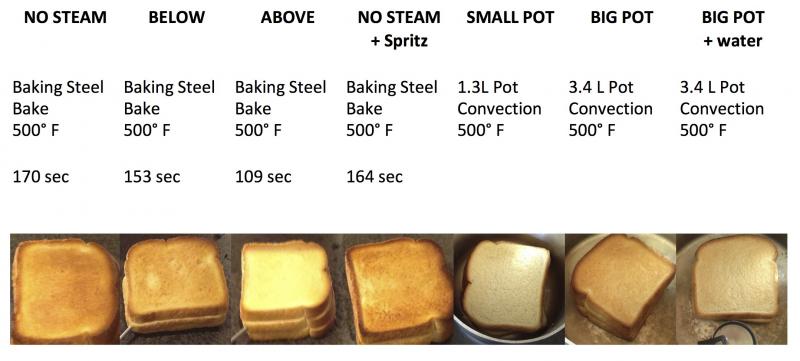
Measuring Oven Steam?
Does anyone out there have a method of measuring oven steam? I have been trying to think of a way to test some of the many oven steaming methods on TFL without all the time and variability involved in baking real loaves of bread each time. Here is what I came up with:
I wanted some sort of artificial bread I could use as a standard test piece and I found it at Stop and Shop, where I bought several loaves of "Big Daisy Bread". In each test, I baked a stack of 3 slices of Big Daisy. I took pictures at various stages and, when possible, I inserted a probe to measure the temperature at the center of the middle slice to see how fast it heated up.
My oven is a Wolf L series electric wall oven which heats from both top and bottom in bake mode. For the dutch oven tests, I used two sizes of All-Clad stainless steel pots (pre-heated), and for the regular oven tests I placed the test stack at the center of a pre-heated Baking Steel. To make steam I used an aluminum half-sheet pan with about 2 cups of water, and I preheated the pan until bubbles were present at the bottom of the water. I started by using 2 rolled up towels in the pan, but with evaporation from such a wide pan, the towels did not seem to make much difference. The oven was set to 500° F for all tests, though, in retrospect, 450° F would have been more realistic.
Some of the results are shown in the image below. All photos shown were taken at the 10 minute mark. The no-steam test gave a very toasty top, with a dark brown color, while the whitest result was in the small pot. The times listed are the time taken for the center of the stack to reach 140° F. I am presuming that a good result is a white top, combined with a rapid rise of internal temperature. While the results may not be definitive, I am hoping that they will help to indicate the better methods.
In the regular oven tests, placing the sheet pan above the bread gave a much better result than placing it below. This is probably because the sheet pan provides a cool (roughly 212° F) cover, reducing the direct heating of the top of the stack. Spritzing the stack with water before baking did not seem to have much effect.
The temperature at the center of the stack rose in all cases to about 200° F in a few minutes and stabilized there. The time to reach 140° F was shortest with the sheet pan above, indicating that, despite the reduced direct heat, the steamy air was transporting heat effectively, perhaps by condensing on the cool bread.
In the dutch oven tests, the small pot gave the best result, while the larger pot produced quite a lot of browning, presumably because the steam was diluted too much. The browning in the large pot could be reduced significantly by adding a small metal container of water inside the pot to provide extra steam.
Of the methods tested, a snug dutch oven gave the best result, followed by either a larger dutch oven with extra water or a half-sheet pan placed above in a regular oven. This is consistent with my baking experience where the dutch oven has been very reliable but steaming from below was disappointing.
To see how this worked out with real bread, I baked a Tartine-style 20% whole-wheat loaf on the baking steel at 450° F, with the steam pan above it for the first 20 minutes. After removing the steam pan, I switched to convection bake for the next 20 minutes at 425 - 400° F. The photos show reasonable results, much better than I had obtained with steam below or at the side.


I'd like to know what the experts think. Does this sort of simple test make any sense?
Is there a better way of finding out what is going on in the oven?
- Colin


I have had a similar thought that it would be great to measure steam, but had no idea how. Not sure I understood your test. Were you heating bread that had already been baked? If so, I am not sure that would be an accurate measurement of the moisture in a dutch oven, since the moisture is generated by the steam rising from the wet dough, it would be tough to measure that since the amount of moisture generated is related to the hydration of the dough.
Yes, the bread was already baked. My idea was that it was not a perfect replica of dough, but that it would be similar enough in porosity, etc. to give some insight.
So I was surprised that it contained enough moisture that the Dutch Oven still showed up as the best method, with essentially no browning after 10 minutes. Presumably it would be even more steamy with real dough.
The other surprise for me was just how important radiation was, since there was a huge difference between steam pans above and below. This is mentioned as a secondary factor in some discussions, but it seemed to be critical for my oven. I tried another test to block radiation with no steam by putting a 1/2 inch thick room-temperature piece of steel above. After 10 minutes, there was no browning, and the internal temperature rose more slowly than when I used steam.
After thinking about your comment, maybe I could use some commercial dough for a test, but it would be a little tricky to get consistent shapes and temperature measurements.
Colin